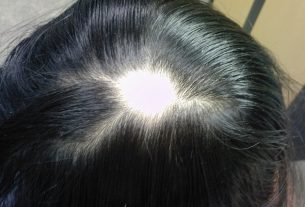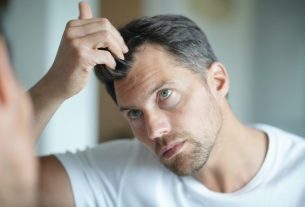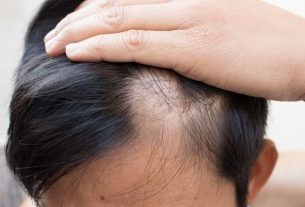Some remedies for baldness, such as minoxidil or finasteride, may be recommended by the dermatologist for the treatment of baldness, as they act by stimulating hair follicle growth or preventing hair loss due to hormonal changes.
Baldness, also known as androgenetic alopecia, is characterized by the reduction or absence of hair strands, which results from the sensitivity of hair follicles in certain areas of the scalp to androgens, a process that interferes with treatments. Check out the main symptoms of baldness.
These remedies can be used orally or applied directly to the skin of the scalp, and should only be used if recommended by a doctor, as they have some contraindications and can cause side effects.

Main remedies
Some of the remedies that may be prescribed by your doctor to treat baldness are:
1. Minoxidil
Minoxidil is a remedy for hereditary baldness, which mainly affects men, and works by stimulating hair follicle growth and increasing the caliber of blood vessels, improving circulation in the area and prolonging the hair growth phase. Learn more about minoxidil.
This remedy is found in the form of a hair solution in concentrations of 2% or 5%, and must be applied directly to the scalp.
How to use: The minoxidil solution can be applied to the dry scalp, in areas where the hair is weaker, with the help of a massage, twice a day. Generally, 5% solutions are prescribed for men and 2% solutions are indicated for women and the amount that should be applied is 1 mL at a time, and the duration of treatment is about 3 to 6 months or as recommended by the doctor.
Who shouldn’t use: minoxidil should not be used by people allergic to the formula’s components, pregnant women, breastfeeding women and children. The 5% minoxidil solution should not be used in women unless the doctor recommends it.
2. Finasteride
Finasteride is indicated for the treatment of baldness in men with androgenic alopecia, as it helps to increase hair growth and prevent hair loss.
Finasteride is available in pharmacies or drugstores in the form of 1 mg tablets and must be used under medical advice as it can cause side effects such as decreased sexual desire, impotence or even swelling or tenderness in the breasts.
How to use: Finasteride must be taken orally, and the normally recommended dose is 1 tablet of 1 mg per day for at least 3 months, as per medical advice. Learn how to use finasteride correctly.
Who shouldn’t use: This remedy should not be used by people allergic to the components of the formula, women or children, pregnant or lactating women.
3. Spironolactone
Spironolactone is a medicine generally indicated for the treatment of high blood pressure and edematous disorders, however, as it has an anti-androgenic effect, the doctor may prescribe this medicine for the treatment of alopecia in women.
Spironolactone works by slowing the progression of hair loss and promoting hair growth, and can be used alone or combined with minoxidil, to enhance hair growth.
How to use: Spironolactone should be used as directed by the doctor, and may be indicated in doses of 50 to 300 mg.
Who shouldn’t use: Spironolactone is contraindicated for people with allergies to the components, with acute renal failure, significant decrease in kidney function, loss of the ability to urinate, Addison’s disease, hyperkalemia or who are using the medicine eplerenone. Furthermore, it should not be used during pregnancy or lactation.
4. Ketoconazole
Topical ketoconazole is an antifungal used to treat seborrheic dermatitis. Although the main indication is not to treat baldness, it is known that the topical application of this remedy, combined with other remedies for baldness, can be beneficial for people suffering from this disease.
How to use: shampoo with ketoconazole should be applied to the affected parts of the scalp, leaving it to act for 3 to 5 minutes before rinsing. For the treatment of seborrheic dermatitis, it is recommended to apply the product twice a week, for 2 to 4 weeks. To prevent the reappearance of seborrheic dermatitis, the shampoo can be used once a week or once every 2 weeks, as per medical advice.
Who shouldn’t use: Ketoconazole should not be used by pregnant or breastfeeding women or people allergic to ketoconazole or other antifungals such as miconazole, fluconazole or itraconazole, for example
5. Alfaestradiol
Alfaestradiol is a medicine indicated for the treatment of androgenic alopecia in men and women, which is a condition that causes baldness due to hormonal factors, especially testosterone, leading to atrophy of the hair follicles.
This remedy acts directly on the root of the hair follicle, which helps prevent hair loss, and can be found in pharmacies or drugstores in the form of a hair solution for topical use, under the trade name Avicis or Alozex, and should be used with dermatologist recommendation.
How to use: Alfaestradiol should be applied directly to the skin of the scalp, once a day, preferably at night, using the applicator in light movements, for about 1 minute, so that approximately 3 mL of the solution reaches the scalp. Then, massage the scalp to improve product absorption and wash your hands at the end.
Who shouldn’t use: This remedy should not be used on people allergic to the components of the formula, pregnant women, breastfeeding women and people under 18 years of age.
6. Cyproterone acetate
Cyproterone acetate may be recommended by the doctor for the treatment of baldness in women, due to hormonal changes, as it has antiandrogenic action.
This remedy should only be used under medical advice and can be found in the form of 50 mg or 100 mg tablets.
How to use: Cyproterone acetate must be taken orally, and the doses must be advised by the doctor on an individual basis.
Who shouldn’t use: Cyproterone acetate should not be used during pregnancy, lactation, in case of liver disease, Dubin-Johnson and Rotor syndrome, people with a history of jaundice or persistent itching during a previous pregnancy, history of gestational herpes, current liver tumors or previous history of meningioma, debilitating diseases, severe chronic depression, history of thrombosis, severe diabetes with vascular changes, sickle cell anemia or allergy to the components of the formulation.
In addition to medications prescribed by your doctor, nutritional supplements can be combined with vitamins, minerals and antioxidants, such as B vitamins, vitamin C, vitamin E, zinc and amino acids, for example, which can contribute to hair growth. See examples of supplements for hair loss.

Sign up for our newsletter and stay up to date with exclusive news
that can transform your routine!
Warning: Undefined array key "title" in /home/storelat/public_html/wp-content/plugins/link-whisper-premium/templates/frontend/related-posts.php on line 12
Warning: Undefined array key "title_tag" in /home/storelat/public_html/wp-content/plugins/link-whisper-premium/templates/frontend/related-posts.php on line 13



